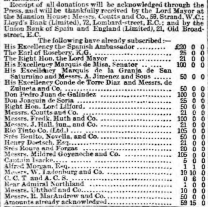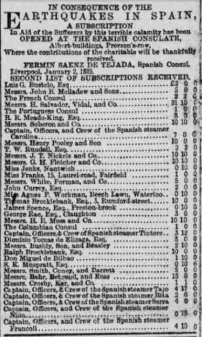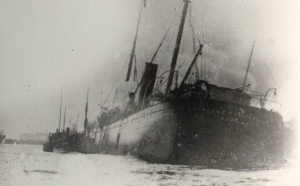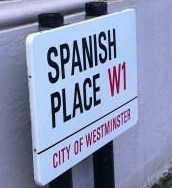
Band Aid. Live Aid. Sport Aid. Comic Relief. Children in Need. Over the last thirty years, we in the UK have embraced the concept of big, multimedia fundraising platforms, whether for longstanding charities or for specific disasters and emergencies. But charity fundraising is very far from a twentieth-century phenomenon. For those of us interested in the Victorian period, nineteenth-century newspapers are bursting with appeals for public contributions and subscriptions to funds for local, national and international causes.
Victorian Britain’s Anglo-Spanish elite embraced this ‘subscription fever,’ using appeals and newspaper pages to draw the British public’s attention to Spanish charitable and – inevitably – political causes. During the last quarter of the nineteenth century, we find appeals led by eminent Condes, Duques, Marqueses and even the occasional untitled merchant for the victims of disasters as varied as the Third Carlist War (1874), a hurricane (1878), earthquakes (1885), floods (1891), and the colonial wars in Cuba and the Philippines (1896, 1898). The appeals followed a similar pattern: shortly after the disaster, a group of high-profile Anglo-Spanish merchants, financiers, diplomats and their British supporters would get together, persuade one or more banks to take in donations, and track support through the pages of newspapers of record such as the London Standard or the Morning Post. The resulting lists, like the one above, allow us an intriguing insight into charitable networks of individuals, businesses and organizations with Spanish connections.
The list of regular organizers and supporters of these subscriptions is a ‘who’s who’ of Anglo-Spanish high society. Appeals were generally headed by a triumvirate of Marqueses: de Misa (aka the Conde de Bayona), de la Granja de San Saturnino, and de la Casa Iglesia (also Spanish Ambassador). Other big-spending individuals include the general merchants Pedro Juan Galindez, Domingo Benito, Francisco Garcia Gaston and the cork merchant Joachim Soria. The most prominent companies include the brokers Frederick Huth & Co., the bankers Mildred Goyeneche & Co., Matheson & Co.,the famous Rio Tinto mining company, the infamous Zulueta & Co., Spanish merchant houses Roura & Forgas and Mancha & Co., and the multinational German merchant house, Uhthoff & Co.
But it wasn’t just the ‘big names’ who contributed. The subscription lists also allow us to identify small-scale business owners and interested expats who expressed their connection to their homeland through repeated small donations. These include Zaragoza-born embassy worker Nicasio Jauralde and his son, Carlos, wine merchant Alejandro Mañero, bank cashier Santiago Laborda, government official Salvador Travado, Valladolid-born Jose Gallostra y Wallace, commercial clerk Jose Maria Palacio, Madrid-born Enrique Pastor y Bedoya, Jose Fernandez de Cossio, and Eugenio – or possibly Eugenia – Alvarez.
 Whether they were super-wealthy or merely comfortable, most contributors were – unsurprisingly – based in London. Nonetheless, we do find representation from other areas, most especially via regional consulates – contributions came in on various occasions from Ardrossan, Cardiff, Dublin, Dundee, Glasgow, Liverpool, Southampton and Swansea. In Liverpool in 1885, the Spanish Consulate set up a local subscription in aid of the victims of the Spanish earthquakes, whose list of subscribers provides a real ‘who’s who’ of the UK’s second largest Anglo-Spanish settlement, ranging from millionaire shipowners to ship’s crews and boarding house keepers (Liverpool Mercury, 26 Jan. 1885: 1; left).
Whether they were super-wealthy or merely comfortable, most contributors were – unsurprisingly – based in London. Nonetheless, we do find representation from other areas, most especially via regional consulates – contributions came in on various occasions from Ardrossan, Cardiff, Dublin, Dundee, Glasgow, Liverpool, Southampton and Swansea. In Liverpool in 1885, the Spanish Consulate set up a local subscription in aid of the victims of the Spanish earthquakes, whose list of subscribers provides a real ‘who’s who’ of the UK’s second largest Anglo-Spanish settlement, ranging from millionaire shipowners to ship’s crews and boarding house keepers (Liverpool Mercury, 26 Jan. 1885: 1; left).

Occasionally, enthusiastic fundraisers went above and beyond the familiar subscription. In Birmingham in 1874, the merchant Augurio Perera (better known as one of the founders of lawn tennis) organized a grand charity concert in aid of ‘the sufferers of the wretched civil war still raging in the North of Spain’ (Birmingham Daily Post, 6 Jun. 1874: 8). In Liverpool eleven years later, the Anglo-Spanish merchant Henry Manuel de Soberón went one step further in his response to the Santander Disaster of 1893. Soberón had a particular interest here; his father, Manuel, had come to Liverpool from the tiny village of La Franca, a day’s walk from Santander.
It’s worth pausing a moment on this, Spain’s worst civil disaster of the nineteenth century (you can read a detailed account, in Spanish, here). On 3 November 1893, the steamship Cabo Machichaco (right), laden with a cargo of petroleum and concealed dynamite, exploded in Santander harbour. Almost 600 people were killed, including the crews of several ships, first responders, bystanders, and most of the city’s civil and military officials, including the civil governor. Almost every building in the harbourfront Calle Méndez Núñez was levelled, and wreckage and body parts were recovered from up to eight kilometres away. It was a devastating event, which the British media followed in obsessively gory detail. The Spanish novelist José María de Pereda memorialized the story in an 1896 novella, Pachín Gonzalez, which follows a young man caught up in the disaster.
As usual, London’s leading Spanish expats moved swiftly. Within a week of the disaster, a committee was formed in London, ‘composed of their Excellencies Marquis de Misa, Count de Bayona, and Count de Torre Diaz; Marquis de la Granja de San Saturnino, Don Pedro Juan de Galindez, and Don Joaquin de Soria’ (London Standard, 14 Nov. 1893). Regular subscription lists were published throughout November, and reflecting the gravity of the disaster, donations came not only from the Anglo-Spanish community’s usual suspects, but also from the Lord Mayor of London and the Foreign Secretary, Lord Rosebery (their participation in a ‘foreign’ fund was not without controversy on the part of those who felt their efforts should be concentrated a little closer to home). In January 1894, the committee remitted £1102 (equivalent to around £66,000 today) to Santander (Oxford Journal, 6 Jan. 1894: 7).
Up in Liverpool, things took a little longer to get going. In February 1894, announcements appeared in Liverpool and Manchester newspapers advertising a charity football match in aid of the Santander Disaster Fund, organized by Soberón and his business associate John Glynn. Soberón and Glynn commandeered Goodison Park, where on Friday 16th February, a whole afternoon of entertainments took place, centred on the match between the Everton ‘A’ team and the combined Liverpool and Manchester Pantomime Artistes. It was a huge production: cheap train travel was laid on from Manchester to Liverpool; players were treated to extensive hospitality at Liverpool’s Bee Hotel, the band of the Indefatigable training ship performed; and the non-playing female pantomime artistes competed to raise money by selling sweets, cigars and other trifles to the crowd (Miss Nellie Wilson raised the most money, and was awarded a gold crescent brooch for her efforts; The Era, 24 Feb. 1894: 12).
The match report, published in the Liverpool Mercury on 17 Feb., records a ‘novel football match’, in which ‘the Evertonians, donned in their uniforms of blue, awaited the advent of events in expectancy not unmixed with humour at the eccentric garb of their antagonists’. Costumes, some more appealing than others, included
Mr Albert, of the Shakespeare, in a demoniac costume; the Waller Bros., of Manchester, as negro comedians; Arthur Lester, as a schoolboy; Mr C Dillon as Mrs Sinbad; and “Wee Johnnie”, who, as goalkeeper, created great amusement’ [we are not told how…].
The Evertonians, entering into the spirit, refrained from playing all out, and the artistes triumphed 4-1. Despite the extensive reporting – the Mercury article alone runs to over 1000 words – it has not yet proved possible to discover how much money was raised. While everybody certainly seems to have had fun, this was – as far as I know – the only time the Anglo-Spanish community’s fundraisers ventured into the still-new world of soccer. Imagine what they would make of the dominance of Spanish players in the game today!

IWas a companion to Mrs larrinaga at villa maria Liverpool 1941. D oestrogen any joined have any information about this family.? I have some wonderful memories of life there which I can share with anyone interested.
[…] I’d hate you to think that those reading the columns and viewing the images were just gorging themselves on the details and then moving on to the next tragedy. The coverage was probably helpful to those who were seeking to raise funds for those affected by the disaster. I came across a blogpost by a Dr Kirsty Hooper at the University of Warwick that highlighted the fundraising for Santander across England. London’s leading Spanish expats not only donated to the cause themselves but they convinced many of the leading locals including the Lord Mayor and the Foreign Secretary to put their hands in their pockets. And it wasn’t just the well-heeled who got involved. A charity football match was organised between Everton’s football team and Liverpool and Manchester pantomime artists. The footballers lost. Read about those fundraising efforts here. […]